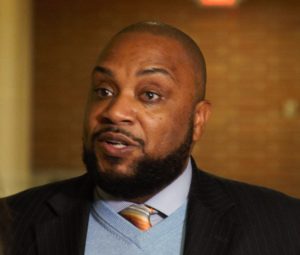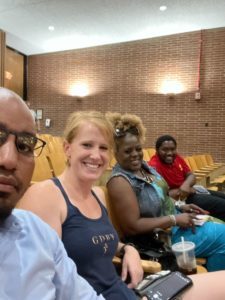By Harold C. Ford
[Editors’ Note: Harold C. Ford, East Village Magazine’s (EVM) education reporter, had intended to write a July piece featuring some good news stories he’d collected about Flint Community Schools (FCS) in the past few months. But, alas, the Flint Board of Education (FBOE) meeting he witnessed on July 20 was likely the most chaotic witnessed by him in more than five years of covering Flint’s public schools. Nonetheless, this piece features “good news stories.” For purposes of readability and thematic tidiness, EVM has divided this month’s Education Beat report into two parts: “same old stories” and “good news stories.” Both pieces are available at the EVM website.]
Good News Stories
While it’s true that Flint Community Schools (FCS) face formidable forces that threaten its survival — a struggle to remain financially solvent; uncertain leadership; declining student enrollment; unsatisfactory scores on state tests; deteriorating buildings and infrastructure; attrition of staff; and legal entanglements — there are enough markers of success to offer FCS-supporters some glimmers of hope for the future:

(Graphic source: Flint Community Schools)
— Flint’s schools reopen to students the first week of August;
— FCS was released from the obligations of an Emergency Deficit Elimination Program (EDEP);
— Fresh new leaders fill the top two positions in the district’s central administration
— A slate of young FBOE hopefuls have announced their candidacies for the board
— Modest improvements in some standardized assessments/tests were reported;
— More than 500 employees will return to work;
— FCS has taken steps to rid itself of some vacant properties;
— Volunteers are making a new home for the district’s robotics team; and
— FCS adopted a new strategic plan covering the years 2022-2027.
Flint students start 2022-23 school year Aug. 3
FCS has survived numerous existential challenges, for now, and is opening its doors to students for the 147th straight year since Flint Central was built in 1875.
According to Kevelin Jones, FCS superintendent, the district expects to enroll at least 3,150 students at the start of the 2022-23 school year. Student enrollment may have stabilized at around 3,000 students after years of precipitous decline.

FCS Superintendant Kevelin Jones. (Photo by Tom Travis)
Emergency plan dismissed
The district’s current financial profile has been buoyed, temporarily, by the infusion of more than $140 million in ESSER (Elementary and Secondary School Emergency Relief) funds from the Federal government in response to the COVID-19 pandemic.
Top two officers are home-grown
Kevelin Jones, superintendent, and Keiona Murphy, assistant superintendent, are home-grown products of Flint Community Schools. They worked their way up the ranks of the FCS administrative hierarchy to the top two positions with hard work and dedication to the district.
Arguably, they embody the “American Dream” as articulated by James Truslow Adams in 1931, that “life should be better and richer and fuller for everyone, with opportunity for each according to ability or achievement” no matter social class or circumstances of birth.
New leadership possible
Upcoming FBOE elections in November, 2022, may bring new faces into the FCS governance hierarchy — notably the district’s seven-person governing board that often seems bogged down in a quagmire of personalities and parliamentary procedure.

FBOE meeting from May 2022. (Photo by Tom Travis)
Five seats, varying in term-lengths, are open for the upcoming Nov. 8, 2022 election. They include:
- A two-year seat with a term that runs November 2022, following election certification, to Dec. 31, 2024;
- A four-year seat with a term that runs November 2022, following election certification, to Dec. 31, 2026;
- Three six-year seats with terms that run Jan. 1, 2023 through Dec. 31, 2028.
The deadline for interested candidates to file petitions with the Flint City Clerk’s office was July 26, 2022.
Board hopefuls
A diverse, five-person slate of fresh-faced candidates attended a recent board meeting. According to Emily Doerr, on of the five-slate of candidates, said the five aim to attend each FBOE meeting but, “not to use it as a platform for campaigning.” Doerr said the slate will be holding “Meet-the-Slate” events until the November election. The five-slate candidates include: Dylan Luna, a city/county business development manager; Emily Doerr, a statewide executive director; Melody Relerford, a community health navigator; Terae King, a major corporation store manager; and Michael Clack, former educator and nonprofit director.
While the FBOE election is not until November, the slate announced they have scheduled nine “meet and greet” sessions at every ward in the city during August:
- Aug. 8: Ward 1, Clara Hilborn Park; 5-7 p.m.
- Aug. 9: Ward 9, Windiate Park; 5-7 p.m.
- Aug. 10: Ward 3, Kearsley Park; 5-7 p.m.
- Aug. 13: Ward 7, Court Street Village office; 4-6 p.m.
- Aug. 16: Ward 4, Longway Park; 5-7 p.m.
- Aug. 22: Ward 2, Sarvis Park; 5-7 p.m.
- Aug. 23: Ward 8, Sarginson Park; 5-7 p.m.
- Aug. 24: Ward 6, Ballenger Park; 5-7:p.m.
- Aug 29: Ward 5, Dort Park; 5-7 p.m.

A slate of five FBOE candidates at last week’s board meeting. Clockwise from top left: Dylan Luna; Emily Doerr; Melody Relerford; Terae King; (not pictured) Michael Clack. (Photo source: Emily Doerr)
A total of 15 are running for school board positions on the November ballot. Incumbent school board members running for reelection are: Linda Boose (6 year term), Carol McIntosh (6 year term), Chris Del Morone (6 year term) and Allen Gilbert (term to expire Dec. 31, 2024). New candidates include: Claudia Perkins (6 year term), Lakeisha Tureaud (6 year term), Audrey Young (6 year term), Donyele Darrough (4 year term), Leslie Haney (for a term that expires Dec. 31, 2024) and Kasey Calvert (for a term that expires Dec. 31, 2024).
EVM will interview members of the slate in the near future. EVM will also interview and report on other FBOE candidates as it learns of their candidacies.
Modest improvements in some academic assessments
At the FBOE’s June 15 meeting, Diona Clingman, executive director of academics, reported on modest gains made by FCS students on NWEA MAP (Northwest Evaluation Association Measure of Academic Progress) and DIBELS (Dynamic Indicators of Basic Early Literacy Skills) assessments:
- NWEA MAP, math assessment: FCS students who “met their growth projections” rose from 33 percent in 2020-21 to 44.7 percent in 2021-22;
- NWEA MAP, reading assessment: FCS students who “met their growth projections” rose from 32.6 percent in 2020-21 to 43.7 percent in 2021-22;
- DIBELS assessment for K-3 students: FCS students “at or above benchmark” rose from 20.2 percent in 2020-21 to 25.4 percent in 2021-22.
“We’re not where we want to be, but we’re growing,” Clingman said.
NWEA MAP and DIBELS are not tests mandated by the State of Michigan as are the PSAT (Preliminary Scholastic Aptitude Test), M-STEP (Michigan Student Test of Educational Progress), and the Michigan Merit Exam (a battery of four tests).
500+ employees continue to serve Flint schools
More than 500 employees in ten or more categories of employees continue to service Flint’s public-school youngsters no matter the district’s stability or instability. All employee groups will be on duty the week of Aug.1 as FCS opens doors to students for the new school year.

Doyle-Ryder Reading Specialist Shari Burdt enthusiastically greets students as they file into the gynamsium to learn their room assignements. Burdt has taught for 49 years and has been at Doyle-Ryder for 10 years.
As reported by Jones at the July 20 FBOE meeting, district employees include those in four categories: United Teachers of Flint, 290 professional educators; Congress of Flint School Administrators, 20 administrators; Local 517 of the Service Employees International Union, 100 paraprofessionals; and 50 professional and technical staffers.
Several employee groups provide “contracted services” including: building secretaries; food service employees; maintenance workers; drivers; behavioral specialists; nurses; and janitors.
Schools for sale
FCS has plentiful abandoned buildings and vacant properties that drain the district of financial resources, are targets for arsonists and ne’er-do-wells, and offer an opportunity for needed revenue if put on the market and sold.

Shuttered Lowell Jr. High School on Flint’s northeast side. (Photo by Tom Travis)
In June, FCS leadership moved forward with plans to rid the district of 13 abandoned properties and buildings that include: Cook; Dort; Garfield; King; Johnson; Lowell; Manley; Merrill; Stewart; Washington; Williams; Wilkins; and Zimmerman.

Shuttered Garfield School in Flint. (Photo by Tom Travis)
New home for robotics team
The Friends of Jaguar Robotics Team consisting of a school principal, FCS teachers and other staff, and volunteers were given FBOE approval to do some demolition and clean-up of two rooms at Southwestern Academy for the purpose of building a robotics lab. The clean-up and renovation will be done by volunteers at no cost to the district.
Strategic plan adopted
EVM reported on the plan’s Executive Summary in June. The Executive Summary, Addendum, and Appendices can be found at the district’s website.
The 56-page Addendum offers greater detail about the plan’s six “Dream Big Priorities”: Scholar Focus; Teaching and Learning; Climate and Culture; Staffing; Finance; and 21st Century Learning Environments.
Additionally, 21 pages of the Addendum flesh out five “Strategic Priorities” and accompanying “Evaluation Models” for the following: Scholar Focus; Teaching and Learning; Climate and Culture; Staffing; and Finance.

Handmade signs held by parents and students at the Flint Board of Education meeting in May 2022. (Photo by Tom Travis)
Some student-centered components of the plan include: mentors for students with poor attendance; specific support for senior students; curriculum surveys to gather student input; more opportunities for special needs students to participate in general education classrooms; Advanced Placement (AP) and International Baccalaureate (IB) classes; meeting alternative education students’ needs more effectively; increased programming for talented students to include fine arts and dual enrollment; play-, project-, problem-, and place-based learning; more robust connections to different careers to include hands on experiences; skilled trades facilities; a cosmetology program; a 40 percent student participation rate in extracurricular activities; creation of middle school intramural sports teams; a biannual student needs survey; and a five percent graduation rate increase.
Other attractive components: once-per-week late start or early dismissal days for planning, coaching, collaboration; a goal of commonality in practices and language; a two-week summer academy for teachers and other employees; a community kitchen for demonstrations and learning; a parent university; community gardens; outdoor learning spaces; a mindfulness room with a yoga center; improvement of safety and security; weekend tutoring and enrichment centers; school-based community service projects; decision-making based on data; and strengthening home-school connections.

Southwestern Academy students fill the hallways in between classes on FCS’ opening day, Monday, August 4. (Photo by Tom Travis)
Language about partnership development is found throughout the plan: “developing business and community partnerships”; “the superintendent shall work with state and city officials”; “maximize all outside funding sources”; utilization of Mott Community College and its Culinary School; more emphasis on learning activities at the Flint Cultural Center; a continuing relationship with the Genesee Academic and Skill Center; and a continued partnership with the Crim Fitness Foundation.
The plan envisions the Northwestern building as a facility for middle school athletics and cultural activities such as art exhibits, fashion shows, and plays. Additionally, an updated pool and workout room would open to employees and community members.
Further, the plan endeavors to: “build four new elementary schools”; “refurbish and modernize Durant-Tuuri Mott”; “refurbish and modernize one…existing high school building”; and “build one new high school.”

Doyle-Ryder 1st grade teacher Kim Montini speaks to her class on Opening Day as they sit at their desks eating breakfast which is provided every morning. Montini has taught on the FCS district for 26 years and taught at Doyle-Ryder for five years. (Photo by Tom Travis)
The strategic plan’s three documents would benefit from a glossary that would aid all in understanding the plentiful acronyms used throughout. Examples: FBA/BIPs; LLI; SFA; IQWST; GED; HQ; EDP; CI; SEL; IEP; GCI; MDE; PLC; PBL; MTTS; ERP; SWIS, DIME-A.
A goal critical to the district is found on page 45 of the Addendum document: “The district will retain its current population of scholars and will attract and recruit new scholars.”
As with all strategic plan documents, the challenge is to turn the words on paper into achievements.
EVM Education Beat reporter can be reached at hcford1185@gmail.com.


You must be logged in to post a comment.